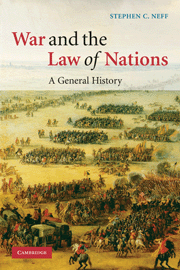PART II - New forces stirring (1600–1815)
Published online by Cambridge University Press: 30 July 2009
Summary
[I]t seemed to be to the advantage of human interests to … make a kind of business of war and to reduce it into the form of an art.
Samuel PufendorfIn the seventeenth and eighteenth centuries, the nation-state (along with much else) emerged in recognisably its modern form. Along with it came modern international law – appropriately labeled as ‘the law of nations’. The decisive contribution in this direction was made early in the seventeenth century by the Dutch lawyer (and theologian) Hugo Grotius, in his famous treatise On the Law of War and Peace, first published in France in 1625. Grotius spoke of this law of nations in careful contrast to the older law of nature, which had dominated international legal thought throughout the Middle Ages. For our purposes, the new law of nations had two outstanding features that distinguished it from the older natural law. The first was that it focussed on the rights and duties of states as such – i.e., that it was a law applicable only to states. It was therefore in sharp contrast to the older natural-law way of thinking, in which principles of universal application had been applied, with as little distortion as possible, to the conduct of rulers and private individuals alike. The second innovation of the law of nations was to concentrate on the external actions of states and thereby to forgo considerations of good faith and mental attitude and the like.
- Type
- Chapter
- Information
- War and the Law of NationsA General History, pp. 83 - 94Publisher: Cambridge University PressPrint publication year: 2005



